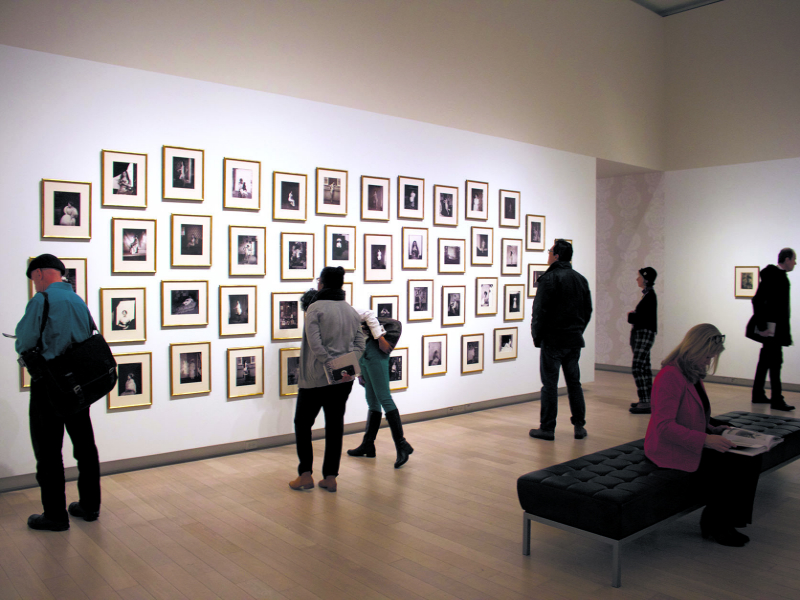Carole and Howard Tanenbaum have always been collectors. They started off collecting mechanical coin banks, tin toys of the 1930s and 1940s and weather vanes. Later, they began to focus on art, collecting paintings, prints, sculptures and drawings.
Then, in the mid-1970s, they became immersed in photography, a medium that was not taken very seriously as an art form at the time. The Tanenbaums were some of the very first photography collectors, and now, almost 50 years later, have one of the most significant collections in North America.
For the next few months, the Ryerson Image Centre (RIC) will be exhibiting over 200 photographs that are part of the Tanenbaums’ private collection. The exhibition, called “True to the Eyes” is open until April 7, and shows just a fraction of their collection, which currently has well over 1,000 photographs.
Among the photographs being showcased are works by Canadian photographer Rafael Goldchain, who was present at the exhibit’s opening night, as well as photos by Jim Goldberg, Lisette Model, Diane Arbus, Ernest J. Bellocq and Mary Ellen Mark.
The couple – Howard is a lawyer, real estate developer and financier, and Carole, a former art dealer and expert in vintage jewelry – began their art collection with a few pictorial photographs by Peter Henry Emerson, as well as some works by John Thomson.
“[The work] was easy to relate to and beautiful,” said Carole Tanenbaum during a speech at the exhibit’s opening in January. “It was a great transfer into the world of photography.”
They soon began to travel to major cities like New York, Paris and London to view more photography collections. “The more we saw, the more we educated our eye. We realized that the photos that interested us most were the ones that informed us on many levels. We needed to engage, to interact with the subject matter. That, above all, was our main, although unconscious at the time, objective.”
READ: J.LEAD PROGRAM TARGETS JEWISH STUDENTS FROM RUSSIAN-SPEAKING BACKGROUNDS
The Tanenbaums were never influenced by things that they saw in popular culture nor did they allow for other people’s opinions to sway their own. They would get photographs from flea markets and antique stores, and in galleries and art auctions, collecting photos that they connected with.
“We never get tired of our collection and we never swap pieces or sell them. It seems that when we buy a photograph, it reaches us in a way that it becomes part of us,” said Carole. “It is not the collection as a whole that we like to reflect upon, it is the individual pieces that constitute the collection.”
Their collection is unique not only because of its scope, but because of its diversity. From 19th century anonymous daguerreotypes, to iconic pieces by famous photographers, the Tanenbaums collect anything that intrigues them. And their collection just keeps on growing.
“We continue to collect with the same passion and interest we have had for close to 50 years,” said Carole Tanenbaum. “We live actively with our collection, never tiring of the images we select. They are part of our lives.”

Southworth & Hawes, [Portrait of two young women], ca. 1850, daguerreotype,
uncased. (The Howard and Carole Tanenbaum Photography Collection)
Paul Roth, the director of the RIC and one of the co-curators of the exhibition, said that the Tanenbaums’ collection shows how photography has grown as a medium, and came to be known and understood as an art form by many people over the decades.
There are many themes that are prominent throughout the collection, including the lives and independence of women, civil rights, nature and land, wealth and poverty, connections within families as well as more specific photographic topics, such as Niagara Falls. Genres included in the collection are art photography, documentary work, commercial landscapes, studio portraiture, family pictures, among many other things.
According to Roth, Howard Tanenbaum has a deep interest in 19th century work, and has one of the biggest daguerreotype collections in the world. Currently, he is focusing on collecting images of historic Palestine, Old Jerusalem and more broadly, the Middle East.
“They’ve always collected in an instinctive way, they’d get excited about certain subjects, certain images, certain photographers,” said Roth. “I think what gets them really animated is that photography is a way of understanding people that you otherwise wouldn’t know, that ability of photography to take you on a journey into somebody else’s life, in some other part of the world.”
The Tanenbaums were part of the community of art lovers whose patronage of photography helped it become more popular and taken seriously as an art form, both in Canada and around the world. Roth said this is true for not only contemporary photographers, but they are also dedicated to preserving the memory of photographers of the past, such as William Notman.
“They never really collected for reasons that a lot of collectors get into art — which is that they want to collect as an investment or they want to buy trophies that will make them look like they have good taste — Howard and Carole have never done that,” said Roth.
“When you come in through the show, what we tried to do was to give a sense of that, of their big hearts and their open minds and their democratic approach to collecting. All of these pictures are celebrated by Howard and Carole in their home, and we wanted to pass that spirit of joy onto our audience.”
The couple has been involved with the RIC for many years, and Howard is a member and founding chair of the RIC’s advisory board.
The exhibition runs until April 7 at the Ryerson Image Centre, 33 Gould St. Toronto. A full schedule of free public programming, including curator tours
and talks, is available via ryersonimagecentre.ca/events.
